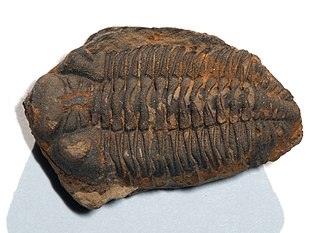Related Research Articles

Trilobites are extinct marine arthropods that form the class Trilobita. Trilobites form one of the earliest known groups of arthropods. The first appearance of trilobites in the fossil record defines the base of the Atdabanian stage of the Early Cambrian period and they flourished throughout the lower Paleozoic before slipping into a long decline, when, during the Devonian, all trilobite orders except the Proetida died out. The last trilobites disappeared in the mass extinction at the end of the Permian about 251.9 million years ago. Trilobites were among the most successful of all early animals, existing in oceans for almost 270 million years, with over 22,000 species having been described.

Phacopida ("lens-face") is an order of trilobites that lived from the Late Cambrian to the Late Devonian. It is made up of a morphologically diverse assemblage of taxa in three related suborders.

Ptychopariida is a large, heterogeneous order of trilobite containing some of the most primitive species known. The earliest species occurred in the second half of the Lower Cambrian, and the last species did not survive the Ordovician–Silurian extinction event.

Dalmanitidae is a family of trilobites in the order Phacopida that lived from the Floian (Ordovician) to the Devonian and includes 33 genera.

Calymenina is a suborder of the trilobite order Phacopida.

Acastoidea is a superfamily of trilobites from the order Phacopida, suborder Phacopina. This superfamily is divided into two families, Acastidae and Calmoniidae. This superfamily is distinguishable from the Phacopidae in that eyes are closer to the glabella and that the glabella has lobes, unlike the genera in Phacopidae. Acastoidea was first proposed by T.J.A. Reijers in 1972.

Acastidae is a family of trilobites in the order Phacopida, suborder Phacopina, superfamily Acastoidea, containing the following genera:

Calmoniidae is a family of trilobites from the order Phacopida, suborder Phacopina, superfamily Acastoidea.

Encrinurus is a long-lived genus of phacopid trilobites that lived in what are now Africa, Asia, Australia, Europe, North America, and South America from the middle Ordovician to the early Devonian from 472 to 412.3 mya, existing for approximately 59.7 million years.

Achatella is a genus of trilobite in the order Phacopida, which existed in what is now Ontario, Canada. It was named by Delo in 1935, and the type species is Achatella achates, which was originally assigned to the genus Dalmanites by Billings in 1860. Achatella also contains the species Achatella billingsi, and Achatella truncatocaudata.
Aegrotocatellus is a genus of trilobite in the order Phacopida, which existed in what is now Nunavut, Canada. It was named by Adrain and Edgecombe in 1995, and the type species is Aegrotocatellus jaggeri, a species named after British musician Mick Jagger.

Encrinuroides is a genus of trilobites in the order Phacopida, that existed during the upper Ordovician in what is now Wales. It was described by Reed in 1931, and the type species is Encrinuroides sexcostata, which was originally described under the genus Cybele by Salter in 1848. It also contains the species, Encrinuroides enshiensis, Encrinuroides insularis, and Encrinuroides rarus. The type locality was in the Sholeshook Limestone Formation.
Erratencrinurus is a genus of trilobites in the order Phacopida, that existed during the upper Ordovician in what is now northern Germany. It was described from glacial erratics by Krueger in 1972, and the type species is Erratencrinurus capricornu.
Acastocephala is a genus of trilobite from the middle Silurian, known from the United Kingdom.

Encrinuridae is a family of trilobite within the order Phacopida that lived in what would be Africa, Asia, Australia, Europe, North America, and South America from the middle Ordovician to the early Devonian from 479 to 412.3 million years ago, existing for approximately 66.7 million years.

Homalonotidae is a family of trilobites that lived from the Ordovician to the Devonian. They are characterised by a shovel-like cephalon (head), and are closely related to the family Calymenidae.

Calymene celebra is a Silurian species of trilobites of the order Phacopida and also the state fossil of Wisconsin. It is found in Illinois, Indiana, and Wisconsin.

Cheirurina is a suborder of the trilobite order Phacopida. Known representatives range from the uppermost Cambrian to the end of the Middle Devonian (Givetian). Cheirurina is made up of a morphologically diverse group of related families.

Librostoma is a subclass of trilobites defined by having a natant hypostome, which is a hypostome that is free from the anterior doublure and aligned with the anterior of the glabella, this is unlike a conterminant hypostome, which is attached to the exoskeleton.

Gregory Donald Edgecombe is an American paleontologist who is a merit researcher in the department of Earth Sciences at the Natural History Museum, London. He is a leading figure in understanding the evolution of arthropods, their position in animal evolution and the integration of fossil data into analyses of animal phylogeny. As a palaeontologist, he is also an authority on the systematics of centipedes – and a morphologist whose work contributes to the growth and methods of analysis of molecular datasets for inferring evolutionary relationships.
References
- ↑ "Phacopida Fact Sheet". www.trilobites.info. Archived from the original on 28 August 2008. Retrieved 2008-09-07.